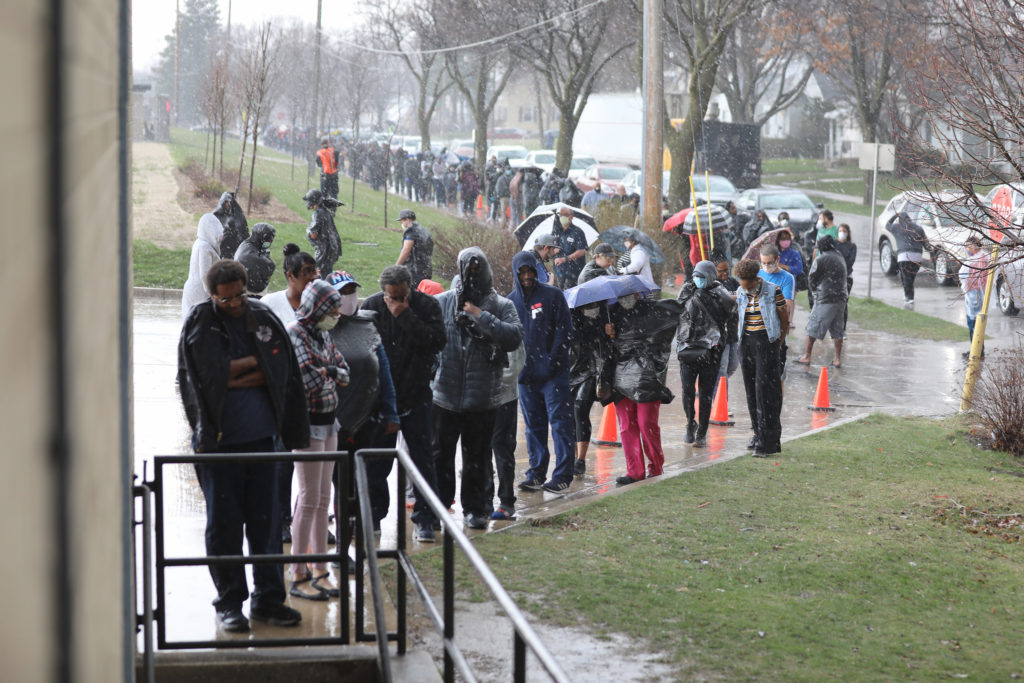Kim Fellner shares lessons from the All Hands Brigade’s experience moving from on-the-ground to remote voter engagement in Wisconsin — with cautions about the VAN, observations on relationship-building via text, the importance of robust vote-by-mail, and the enduring importance of human connection.
Hah! Wisconsin’s majority-Republican legislature, abetted by conservative ideological majorities in both the State and U.S. Supreme Courts, tried every ploy to keep Wisconsinites from casting their ballots–cutting off an extended period for absentee voting and demanding in-person voting in the midst of the raging COVID-19 pandemic. But when the election results were released on April 13, Wisconsin voters had foiled them. By mail, and by literally putting their bodies and lives on the line, they voted in droves and handed the Republicans a blistering defeat. Progressives won a hotly contested seat on the State Supreme Court, a difficult Appeals Court race and spending measures for public schools in both Milwaukee and Racine (although Racine’s hairline 5-vote edge has triggered demand for a recount).
I watched the Wisconsin election saga unfold as part of All Hands Brigade, a collaborative of seasoned organizers and activists passionate to enlist as volunteers against encroaching fascism threatening our democracy. Launched at the beginning of 2020 to add skilled and strategic capacity to progressive electoral organizing in key states, the Brigade is anchored by Just Strategy, the (c)(4) sister organization of the Seattle-based Alliance for a Just Society.
As a first test, the Brigade had planned to send a team of eight to Wisconsin to assist Wisconsin Organizing Together (WOT) and a few local groups in the lead-up to the April 7 election. The first Brigadista, Annalee McConnell, hit the ground in Milwaukee on March 6, so she was able to spend about 10 days in person with the WOT team. But just a few hours after the second Brigadista, Leslie Abbott, rolled her motor home into the driveway of the large Airbnb we’d rented in Racine, the coronavirus rolled in too. Leslie had time for just one meeting with the local folks before in-person became online—and organizing 2020 became a whole new ballgame for everyone.
Over the next three weeks, leading into the April 7 election, the state became a real-time lab for an entirely virtual campaign. Members of the Brigade, hunkered down in their homes across the country and expanded by a few dozen friends, helped WOT reach out to Wisconsin voters by any socially-distanced means possible. “Through every call we made, on message boards, Facebook posts, and text threads, we saw that people in Wisconsin were mad at their leaders for failing to take action and that motivated them to vote early like never before, both in person and by mail,” said Peter Drummond, who heads WOT. “As organizers, the biggest thing we had to do was be present, available, and well informed to help folks navigate how to safely engage in the election, despite conditions that changed every day, and during a pandemic.”
Given the short timeframe and chaotic environment, the Brigade segued from its original plans to help with interactive, on-the-ground infrastructure and canvass support, and took on the dogged chugga chugga of voter contact, focusing on Racine. We started out on phones to do voter ID, later moving into texting for GOTV, and chasing down absentee ballots right through the final hours of Election Day. Ultimately, the cohort generated 20% of all the texts sent by WOT volunteers.
The pressure cooker of Wisconsin, locked down and in constant flux, left little room for navel-gazing—merely the need to grab every available tool and forge ahead. But in addition to chalking up an exciting win, we came away with some fodder for the road ahead.
Thumbs down for the VAN phone lists
Unsurprising to most folks who do electoral work, the call lists pulled from the SmartVAN were appallingly bad, rife with disconnected phones and wrong numbers. In the first 10 days or so, without access to an auto-dialing program to weed out those calls, the process was torturous, and unproductive. Out of every 25 calls, one might get two or three conversations, although things improved toward the end with a better phoning system. And almost all the voters on our lists skewed old.
In this time of greater social distancing, lists of good emails and cell phone numbers will be pure gold; it would be well worth doubling down on list augmentation over the next three months, and all of our organizations should make sure that our members, friends and family lists are updated and entered.
The phone lists also raised the question of what to do regarding contact with older voters whose internet access and comfort with new technology/social media may be lacking; it feels like we may need a separate communications plan for those constituents.
Thumbs up for texting
Texting (or SMS) turned out to be a far more satisfying platform. We were encouraged by the level of response, especially on Election Day, as agonized voters tried to deal with absentee ballots that hadn’t arrived, shuttered polling places, and long lines that could threaten their lives.
When individuals responded to our text, almost all of us abandoned strict orders to stick to canned responses and added genuine, personal answers to the core messages. In a noticeable number of instances, we found ourselves in a small back-and-forth dialogue.
While groups are beginning to have some level of tested experience with engaging their own social media networks, little has yet been done with engaging voters off the files in a similar fashion. If the campaign texter could go back to those people a week later and say, “We talked before. I’d love to hear about what you experienced on Election Day and talk with you about what’s next for Wisconsin. What’s the best way to do that?” there seems to be potential to develop a social media relationship off the voter lists.
Message, Medium, Metrics, Meaning
Personally, I’ve always considered relational organizing as a “rebranding” of union or community organizing 101: building relationships and leadership to win power for the communal good, using short-term gains toward a longer-term vision, transforming both the individuals who become active and the larger society. However, in the field of political organizing, the common practice has been transactional “persuasion” — metrics-based issue or candidate messaging to produce a specific voter outcome.
In the past five years or so, though, there has been an emergent effort to blend these two approaches. Organizations like Working America, AFL-CIO helped pioneer a political canvass based on listening to the concerns of potential voters and using that as context for a conversation on issues and candidates; and community based organizations started more direct forays into political activity. Additional leavening has come from the expanded use of social media, and questions about the role that online communications, texting, and new digital platforms can play, either augmenting or supplanting in-person interaction. Especially in younger organizing cohorts, there has been increasing reliance on digital communication, which can dramatically expand reach at reduced cost—but its ability to build power or leadership, or to inspire transformation, has remained murky.
Post 2016, as both funders and progressive groups seized on new studies suggesting that communications based on pre-existing relationships could boost voter turnout–especially in under-represented communities of color and among young people–the Analyst Institute (AI), which had conducted some of that testing, felt obligated to push back against the conflation of “relational organizing” and “relational voter turnout” (RVT). The AI delineated RVT as a promising tactic “that can be used as part of a long-term community organizing effort (relational organizing) or applied within a more transitory, election-specific voter contact.”
In addition, despite some aspirational language to the contrary, relational organizing with members/constituents often remains quite different from political engagement with voters beyond an organization’s base. The former is still about depth and transformation as you build power; the latter is still focused on achieving measurable outcomes to scale within a very defined time span.
Our texting stint reinforced that the medium is not the entirety of the message, and social media or a cool digital platform don’t automatically mean relational. Just as in the trend to replace traditional door-to-door canvassing with more relational “deep canvass” conversations, building that interaction requires making a connection that builds off, but does not rigidly follow, a script. That, in turn, requires a different kind of training and supervision for the people who engage in it, one that equips them to know what needs to remain constant, and where there is leeway to improvise. It also suggests a revised standard of productivity, since anything relational, by definition, takes more time. And it requires, as well, the potential for ladders of engagement that may begin with a non-personal outreach, but can be nurtured over time.
Vote by Mail in our Sights
Much of the initial discussion about the Wisconsin Election Day S***show focused on the portentous nature of Republican strategy and tactics, unbounded by any sense of decency—and the likelihood of meeting those tactics in state after state throughout this tense election year.
Fielding texts from Wisconsin voters on Election Day humanized the heartbreak. “I am wheelchair bound and I have not received my absentee ballot yet,” texted one voter who couldn’t get to a polling place. “I am going to vote but I am furious,” said another. “I requested an absentee ballot more than two weeks ago and it still hasn’t come. I refuse to let the Republicans steal my vote and if they force me to break quarantine I will, but it is criminal in my opinion.”
The media images of lines of voters in surgical masks also snaked its way into the public eye, reanimating a more robust discussion of Vote by Mail (VBM), more recently rebranded as Vote at Home. It presents an excellent campaign opportunity in Wisconsin and around the country. The beauty is that many of our organizations are well-suited to be part of this kind of campaign, across a broad range of constituencies, and that it holds the potential for tangible benefits in a foreseeable timeframe. It also is an excellent conversation to have with voters through all available platforms, one that provides a non-partisan public service in helping people get absentee ballots and moves seamlessly into opportunities for action and a more robust election turnout in November. “There’s some disappointment about not having a progressive presidential candidate, but VBM is an opportunity to build progressive infrastructure to prepare us, both for this fall and beyond,” observes Just Strategy Executive Director LeeAnn Hall. “We really ought to run with it.”
Taking heart
In her article about stepping into the corona moment, Harmony Goldberg highlights the opportunity to “make meaning,” to “change the public narrative in profound ways.” Those of us who keep faith with relationship-based organizing to generate long-term societal change see this moment as an opportunity to connect prevailing political and policy choices to the painful lived outcomes that so many people are experiencing. But we need only squint through our well-worn trifocal lenses of race, class and gender to see the rocky path of incremental change and the rarity of revolution.
in the past few years, we have become obsessed with turning messages into finely honed narratives that literally move the needle when people hear them—the scientific art of choosing the perfect word or phrase to bring someone closer to your perspective. However, the corona moment in Wisconsin—and everywhere—is a bracing reminder that we are engaging real people, with real feelings, grappling with an surreal situation, where their preoccupations and emotions are overwhelming, and in flux. Likewise, developing organizers who can be nuanced, adaptable and empathetic as well as proficient is an undertaking worth the investment. My belief in data and in rigorous, accountable practice is strong, but in the end, our ability to forge a human connection, and to win, is also dependent on the less precise, but perhaps more profound, calculus of the heart.

